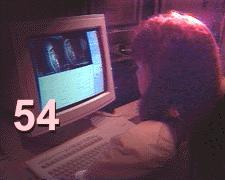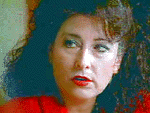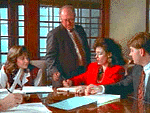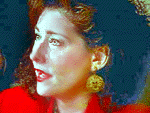|
Module 54 |
Updated: 08/25/2005 |
|
Editing Part I Today's nonlinear computer editors are capable of just about any effect you can dream up. Because of this, it's tempting to try to impress your audience with all the production razzle-dazzle you can manage. But, whenever any production technique calls attention to itself, especially in dramatic productions, you've diverted attention away from your central message. Video professionals-or maybe we should say true artisans of the craft-know that production techniques are best when they are transparent; i.e., when they go unnoticed by the average viewer. However, in music videos, commercials,
and program introductions,we are in an era of where production (primarily editing)
techniques are being used as a kind of "eye candy" to mesmerize audiences. The video
editing system shown below is capable of creating about any type of effect. Even though the traditional rules of editing seem to be regularly transgressed in commercials, music videos, etc., the more substantive productions-especially dramatic productions-seem to generally adhere to some accepted editing guidelines. As in the case of the guidelines for good composition, we are not referring to them as rules. As you will see, many of these guidelines apply primarily to
single-camera, dramatic, film-style production. |
|
Guideline # 1: Edits work best when they are motivated. In making any cut or transition from one shot to another there is a risk of breaking audience concentration and subtly pulling attention away from the story or subject matter. When cuts or transitions are motivated by production content they are more apt to go unnoticed. For example, if someone glances to one side during a dramatic scene, we can use that as motivation to cut to whatever has caught the actor's attention. You may recall the example we gave in Module 51. When one person stops talking and another starts, that provides the motivation to make a cut from one person to the other. If we hear a door open, or someone calls out from off-camera, we generally expect to see a shot of whoever it is. If someone picks up a strange object to examine it, it's natural to cut to an insert shot of the object. Guideline # 2: Whenever possible cut on subject movement. If cuts are prompted by action, that action will divert attention from the cut, making the transition more fluid. Small jump cuts are also less noticeable because viewers are caught up in the action. If a man is getting out of a chair, for example, you can cut at the midpoint in the action. In this case some of the action will be included in both shots. In cutting, keep the 30-degree rule in mind that we previously discussed.
Editing for single-camera production requires great attention to detail. Directors will generally give the editor more than one take of each scene. Not only should the relative position of feet or hands, etc., in both shots match, but also the general energy level of voices and gestures. You will also need to make sure nothing has changed in the scene—hair, clothing, the placement of props, etc—and that the talent is doing the same thing in exactly the same way in each shot. Note in the photos below that if we cut from the closeup of the woman talking to the four-shot on the right, that the angle of her face changes along with the lighting. (Because of the location of the window, would we not assume the key light would be on our left?) These things represent clear continuity problems—made all the more apparent because our eyes would be focused on her.
Part of the art of acting is in to maintain absolute consistency between takes. This means that during each take talent must remember to synchronize moves and gestures with specific words in the dialogue. Otherwise, it will be difficult, if not impossible, to cut directly between these takes during editing. It's the Continuity Director's job to see not only that the actor's clothes, jewelry, hair, make-up, etc., remain consistent between takes, but that props (movable objects on the set) also remain consistent. It's easy for an object on the set to be picked up at the end of one scene or take and then be put down in a different place before the camera rolls on the next take. When the scenes are then edited together, the object will then seem to disappear, or instantly jump from one place to another.
Discounting the fact that you would not want to cut between two shots that are very similar, do you see any problem in cutting between the two shots above? Okay, you may have caught the obvious disappearance
of her earrings
and a difference in color balance, but did you notice the change in the
direction of the key light and the position of the hair on her forehead? Entering and Exiting the Frame As an editor, you often must cut from one scene as someone exits the frame on the right and then cut to another scene as the person enters another shot from the left. It's best to cut out of the first scene as the person's eyes pass the edge of the frame, and then cut to the second scene about six frames before the person's eyes enter the frame of the next scene. The time is significant. It takes about a quarter of a second for viewers' eyes to switch from one side of the frame to the other. During this time, whatever is taking place on the screen becomes a bit scrambled, and viewers need a bit of time to refocus on the new action. Otherwise, the lost interval can create a kind of subtle jump in the action. Like a good magician that can take your attention off something they don't want you to see, an editor can use distractions in the scene to cover the slight mismatches in action that inevitably arise in single-camera production. An editor knows that when someone in a scene is talking, attention is generally focused on the person's mouth or eyes, and a viewer will tend to miss inconsistencies in other parts of the scene. Or, as we've seen, scenes can be added to divert attention. Remember the role insert shots and cutaways can play in covering jump cuts. Guideline # 3: Keep in Mind the Strengths and Limitations of the Medium. Remember: Television is a closeup medium.
Except for establishing shots designed to momentarily orient the audience to subject placement, the director and the editor should emphasize medium shots and closeups. There are some things to keep in mind in this regard. Closeups on individuals are appropriate for interviews and dramas, but not as appropriate for light comedy. In comedy the use of medium shots keeps the mood light. You normally don't want to pull the audience into the actors' thoughts and emotions. In contrast, in interviews and dramatic productions it's generally desirable to use closeups to zero-in on a subject's reactions and provide clues to the person's general character. In dramatic productions a director often wants to communicate something of what's going on within the mind of an actor. In each of these instances, the judicious and revealing use of closeups can be important. |





 An
editor must remember that a significant amount of picture detail is lost in video
images-especially in the 525- and 625-line television systems. The only way
to show needed details is through closeups.
An
editor must remember that a significant amount of picture detail is lost in video
images-especially in the 525- and 625-line television systems. The only way
to show needed details is through closeups.